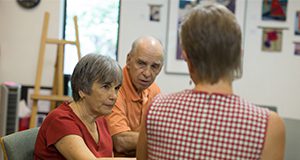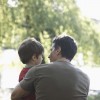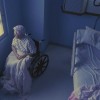As you enter college, you may wonder what it will be like to live in a residence hall and share a space with a roommate. A good roommate relationship can help you navigate many of the changes you are about to make. This new 2-page document discusses six steps you can take to help establish a good relationship between you and your roommate. Written by Suzanna Smith and Heather Wallace, and published by the UF/IFAS Department of Family, Youth and Community Sciences, February 2019.
http://edis.ifas.ufl.edu/fy1480
Tag: Suzanna Smith
The Art of Goodbye: Communication Considerations
 People are frequently at a loss for the best way to begin a discussion about end-of-life concerns with loved ones and health care providers and are also unsure of the topics they should cover. Nonetheless, conversations about end-of-life care and advance directives can help ensure that the person’s wishes are honored. These measures also eliminate much of the difficult decision-making that loved ones typically face at the time of their loved ones’ passing. This 5-page fact sheet, part of a new series entitled The Art of Goodbye, discusses the barriers to discussing the end of life and the process of communication with loved ones and health care providers. Written by Suzanna Smith, Lynda Spence, and Chelsea Tafelski, and published by the UF Department of Family, Youth and Community Sciences, October 2016.
People are frequently at a loss for the best way to begin a discussion about end-of-life concerns with loved ones and health care providers and are also unsure of the topics they should cover. Nonetheless, conversations about end-of-life care and advance directives can help ensure that the person’s wishes are honored. These measures also eliminate much of the difficult decision-making that loved ones typically face at the time of their loved ones’ passing. This 5-page fact sheet, part of a new series entitled The Art of Goodbye, discusses the barriers to discussing the end of life and the process of communication with loved ones and health care providers. Written by Suzanna Smith, Lynda Spence, and Chelsea Tafelski, and published by the UF Department of Family, Youth and Community Sciences, October 2016.
http://edis.ifas.ufl.edu/fy1470
The Art of Goodbye: Why People Are Talking About the End of Life
 Mortality has been a taboo subject for many years. Many cultural, demographic, educational, and policy changes have played a part in a shift toward an increased openness to talking about death as a natural part of life in the United States. This 5-page fact sheet is the first publication in a new series entitled The Art of Goodbye, and it covers changes in living and dying, preferences for the end of life, roles of substitute decision makers in health care, and communication. Written by Suzanna Smith and Lynda Spence, and published by the UF Department of Family, Youth and Community Sciences, October 2016.
Mortality has been a taboo subject for many years. Many cultural, demographic, educational, and policy changes have played a part in a shift toward an increased openness to talking about death as a natural part of life in the United States. This 5-page fact sheet is the first publication in a new series entitled The Art of Goodbye, and it covers changes in living and dying, preferences for the end of life, roles of substitute decision makers in health care, and communication. Written by Suzanna Smith and Lynda Spence, and published by the UF Department of Family, Youth and Community Sciences, October 2016.
http://edis.ifas.ufl.edu/fy1468
Homeless Children Need Preschool (FAR0615/FM1047)
 “During the recent recession, news reports included some sobering video footage from an area surrounding what’s sometimes called the happiest place on earth, Disney World. Unfortunately, climbing unemployment and home foreclosures in the region had left many middle- and working-class families suddenly homeless. Their new, temporary dwelling places were hotel rooms, the couches of friends and family members, homeless shelters, or the family car…” This 2-page Family Album Radio transcript was written by Suzanna Smith, and published by the UF Department of Family Youth and Community Sciences, February 2013.
“During the recent recession, news reports included some sobering video footage from an area surrounding what’s sometimes called the happiest place on earth, Disney World. Unfortunately, climbing unemployment and home foreclosures in the region had left many middle- and working-class families suddenly homeless. Their new, temporary dwelling places were hotel rooms, the couches of friends and family members, homeless shelters, or the family car…” This 2-page Family Album Radio transcript was written by Suzanna Smith, and published by the UF Department of Family Youth and Community Sciences, February 2013.
http://edis.ifas.ufl.edu/fm1047
Foster Parenting (FAR0008/FM065)
 “Eddie Murphy, Duane Culpepper, Superman, Marilyn Monroe, Alonzo Mourning, Cher, Ice T, John Lennon, James Dean, and Babe Ruth: What do all these people have in common? They were foster kids! Foster parenting is a job that gets little attention and is in great demand. It involves taking a child into your home: a child who has been abused, neglected, or abandoned, or whose primary caregivers are unable to meet their parenting duties—and caring for them as if they are one of your own…” This 2-page Family Album Radio transcript was written by Amanda Quaas and Suzanna Smith, and published by the UF Department of Family Youth and Community Sciences, February 2013.
“Eddie Murphy, Duane Culpepper, Superman, Marilyn Monroe, Alonzo Mourning, Cher, Ice T, John Lennon, James Dean, and Babe Ruth: What do all these people have in common? They were foster kids! Foster parenting is a job that gets little attention and is in great demand. It involves taking a child into your home: a child who has been abused, neglected, or abandoned, or whose primary caregivers are unable to meet their parenting duties—and caring for them as if they are one of your own…” This 2-page Family Album Radio transcript was written by Amanda Quaas and Suzanna Smith, and published by the UF Department of Family Youth and Community Sciences, February 2013.
http://edis.ifas.ufl.edu/fm065
Saying Goodbye: Military Deployments (FAR0013/FM072)
 “Those last few hugs, the last few kisses, the last few goodbyes are what many military families across the United States have experienced when seeing a loved one leave for deployment. An estimated 1.4 million servicemen and women serve as active duty members in the Army, Navy, Marine Corps, or Air Force. Deployments are nothing new in the military community. However, during these times of separation, family members of those serving, especially the children, undergo many hardships. Studies show children’s reactions to separation can even lead to depression.” This 2-page Family Album Radio transcript was written by Alexandra Ulrich and Suzanna Smith, and published by the UF Department of Family Youth and Community Sciences, November 2012.
“Those last few hugs, the last few kisses, the last few goodbyes are what many military families across the United States have experienced when seeing a loved one leave for deployment. An estimated 1.4 million servicemen and women serve as active duty members in the Army, Navy, Marine Corps, or Air Force. Deployments are nothing new in the military community. However, during these times of separation, family members of those serving, especially the children, undergo many hardships. Studies show children’s reactions to separation can even lead to depression.” This 2-page Family Album Radio transcript was written by Alexandra Ulrich and Suzanna Smith, and published by the UF Department of Family Youth and Community Sciences, November 2012.
http://edis.ifas.ufl.edu/fm072
What Middle Schoolers Want to Talk About (FAR0804/FM246)
 “Can your middle-schooler talk to you? Most 10- to 14-year-olds want a warm, close relationship with their parents. However, only about a quarter of adolescents nationwide find their parents ‘approachable and available to talk.'” This 2-page Family Album Radio transcript was written by Suzanna Smith, and published by the UF Department of Family Youth and Community Sciences, September 2012.
“Can your middle-schooler talk to you? Most 10- to 14-year-olds want a warm, close relationship with their parents. However, only about a quarter of adolescents nationwide find their parents ‘approachable and available to talk.'” This 2-page Family Album Radio transcript was written by Suzanna Smith, and published by the UF Department of Family Youth and Community Sciences, September 2012.
http://edis.ifas.ufl.edu/fm246
Talking to Children about Disasters (FAR8038/FM248)
 “Natural disasters, refugees displaced from their homes, loss of life . . . even for adults, these tragic events are difficult to understand. Children, too, may find these incidents especially troubling. Adults can help young people make sense of disasters and deal with their feelings by following a few guidelines.” This 2-page Family Album Radio transcript was written by Suzanna Smith, and published by the UF Department of Family Youth and Community Sciences, September 2012.
“Natural disasters, refugees displaced from their homes, loss of life . . . even for adults, these tragic events are difficult to understand. Children, too, may find these incidents especially troubling. Adults can help young people make sense of disasters and deal with their feelings by following a few guidelines.” This 2-page Family Album Radio transcript was written by Suzanna Smith, and published by the UF Department of Family Youth and Community Sciences, September 2012.
http://edis.ifas.ufl.edu/fm248
Sleep Needs for Children (FAR0604/FM181)
 “Does your school-aged child complain about being sleepy during the day, doze off in class, or yawn a lot? Does he or she go to bed late or have trouble falling asleep? If so, your child may not be getting enough sleep.” This 2-page Family Album Radio transcript was written by Suzanna Smith, and published by the UF Department of Family Youth and Community Sciences, October 2012.
“Does your school-aged child complain about being sleepy during the day, doze off in class, or yawn a lot? Does he or she go to bed late or have trouble falling asleep? If so, your child may not be getting enough sleep.” This 2-page Family Album Radio transcript was written by Suzanna Smith, and published by the UF Department of Family Youth and Community Sciences, October 2012.
http://edis.ifas.ufl.edu/fm181
Teen Binge Drinking (FAR1201/FM362)
 “Raising teenagers is a tough job. I know I’m not the only mom who worries about the challenges our children face, including the issue of teenage drinking. There are many reasons to be concerned: Youth who use alcohol are at greater risk for unprotected sexual intercourse, coerced sexual activity, use of marijuana, and poor academic performance.” This 2-page Family Album Radio transcript was written by Suzanna Smith and published by the UF Department of Family Youth and Community Sciences, August 2012.
“Raising teenagers is a tough job. I know I’m not the only mom who worries about the challenges our children face, including the issue of teenage drinking. There are many reasons to be concerned: Youth who use alcohol are at greater risk for unprotected sexual intercourse, coerced sexual activity, use of marijuana, and poor academic performance.” This 2-page Family Album Radio transcript was written by Suzanna Smith and published by the UF Department of Family Youth and Community Sciences, August 2012.
http://edis.ifas.ufl.edu/fm362
Child-Proofing Your Yard (FAR5043/FM323)
 “Once your child first pulls himself or herself onto two feet, normal housekeeping rules fly out the window as every parent makes child-proofing a high priority. These precautions become even more elaborate as the child becomes more mobile and more creative. But experts at the University of Florida point out that a backyard poses just as many hazards—but hazards of a different sort than a home.” This 2-page Family Album Radio transcript was written by Patricia Bartlett and Suzanna Smith, and published by the UF Department of Family Youth and Community Sciences, August 2012.
“Once your child first pulls himself or herself onto two feet, normal housekeeping rules fly out the window as every parent makes child-proofing a high priority. These precautions become even more elaborate as the child becomes more mobile and more creative. But experts at the University of Florida point out that a backyard poses just as many hazards—but hazards of a different sort than a home.” This 2-page Family Album Radio transcript was written by Patricia Bartlett and Suzanna Smith, and published by the UF Department of Family Youth and Community Sciences, August 2012.
http://edis.ifas.ufl.edu/fm323
Hospice Care (FAR5003/FM375)
 “Recently a friend’s mother, Alice, was diagnosed with lung cancer, and even though she received all the possible treatments, the cancer was incurable. She went into hospice care so that she could get professional help in preparing herself and her family for her death.” This 2-page Family Al was written by Suzanna Smith, and published by the UF Department of Family Youth and Community Sciences, August 2012.
“Recently a friend’s mother, Alice, was diagnosed with lung cancer, and even though she received all the possible treatments, the cancer was incurable. She went into hospice care so that she could get professional help in preparing herself and her family for her death.” This 2-page Family Al was written by Suzanna Smith, and published by the UF Department of Family Youth and Community Sciences, August 2012.
http://edis.ifas.ufl.edu/fm375
Caregiver Stress and Elder Abuse (FAR6015/FM406)
 “One out of four people is a caregiver for a family member or friend (AoA). Most of these informal caregivers, as well as paid caregivers who work for agencies or on their own, are able to meet the many challenges of providing care and do an excellent job (National Center on Elder Abuse, 2002). Even so, every year, thousands of reports of elder abuse are confirmed, and unfortunately, elder abuse seems to be on the rise (National Center on Elder Abuse).” This 2-page Family Album Radio transcript was written by Suzanna Smith, and published by the UF Department of Family Youth and Community Sciences, August 2012.
“One out of four people is a caregiver for a family member or friend (AoA). Most of these informal caregivers, as well as paid caregivers who work for agencies or on their own, are able to meet the many challenges of providing care and do an excellent job (National Center on Elder Abuse, 2002). Even so, every year, thousands of reports of elder abuse are confirmed, and unfortunately, elder abuse seems to be on the rise (National Center on Elder Abuse).” This 2-page Family Album Radio transcript was written by Suzanna Smith, and published by the UF Department of Family Youth and Community Sciences, August 2012.
http://edis.ifas.ufl.edu/fm406
Respite Care for Caregivers of Older Adults (FAR6013/FM402)
 “My 90-year-old grandmother lived with my mom and dad in her final years. She was comfortable there and had the help, support and affection she needed. My parents prepared healthy meals for her, took her shopping, to doctor’s appointments, and to visit friends. My grandmother knew she was safe, secure, and loved.” This 2-page Family Album Radio transcript was written by Suzanna Smith, and published by the UF Department of Family Youth and Community Sciences, August 2012. http://edis.ifas.ufl.edu/fm402
“My 90-year-old grandmother lived with my mom and dad in her final years. She was comfortable there and had the help, support and affection she needed. My parents prepared healthy meals for her, took her shopping, to doctor’s appointments, and to visit friends. My grandmother knew she was safe, secure, and loved.” This 2-page Family Album Radio transcript was written by Suzanna Smith, and published by the UF Department of Family Youth and Community Sciences, August 2012. http://edis.ifas.ufl.edu/fm402
Overworked Families (FAR5051/FM407)
 “Most weeks, as I breathlessly try to keep up with my family responsibilities and the demands of my job, I often lament, ‘There just aren’t enough hours in the day!'” This 2-page Family Album Radio transcript was written by Suzanna Smith, and published by the UF Department of Family Youth and Community Sciences, August 2012.
“Most weeks, as I breathlessly try to keep up with my family responsibilities and the demands of my job, I often lament, ‘There just aren’t enough hours in the day!'” This 2-page Family Album Radio transcript was written by Suzanna Smith, and published by the UF Department of Family Youth and Community Sciences, August 2012.
http://edis.ifas.ufl.edu/fm407
Television and Babies' Sleep (FAR0426/FM395)
 “There are a number of video and television programs that have been made for children under the age of three. At times it may be fun to watch your baby or toddler bounce or dance along with the characters on the screen. Many busy caregivers also use these shows to give themselves a little time for a needed break or to prepare a meal or tidy up. However, watching television may not be best for your baby or toddler’s sleep.” This 2-page Family Album Radio transcript was written by Kristen McDanel and Suzanna Smith, and published by the UF Department of Family Youth and Community Sciences, August 2012.
“There are a number of video and television programs that have been made for children under the age of three. At times it may be fun to watch your baby or toddler bounce or dance along with the characters on the screen. Many busy caregivers also use these shows to give themselves a little time for a needed break or to prepare a meal or tidy up. However, watching television may not be best for your baby or toddler’s sleep.” This 2-page Family Album Radio transcript was written by Kristen McDanel and Suzanna Smith, and published by the UF Department of Family Youth and Community Sciences, August 2012.
http://edis.ifas.ufl.edu/fm395
Baby Boomer Family Life (FAR5008/FM389)
 “The first of the baby boomers are getting a lot of press lately as they begin turning 60, and researchers have been exploring how this large generation impacts not only our political and cultural climate, but our families as well.” This 2-page Family Album Radio transcript was written by Suzanna Smith and published by the UF Department of Family Youth and Community Sciences, August 2012.
“The first of the baby boomers are getting a lot of press lately as they begin turning 60, and researchers have been exploring how this large generation impacts not only our political and cultural climate, but our families as well.” This 2-page Family Album Radio transcript was written by Suzanna Smith and published by the UF Department of Family Youth and Community Sciences, August 2012.
http://edis.ifas.ufl.edu/fm389
Teen Birth Rates Decline (FAR1208/FM420)
 “Parents and others who are concerned about teenagers having babies have reason to celebrate. According to the nonprofit research organization Child Trends, the teenage birth rate for 15-19 year olds is at the lowest point in over 40 years. This drop began in 1991 and has roceeded steadily so that it is now one-third lower than the 1991 peak. The other good news is that it continues to fall.” This 2-page Family Album Radio transcript was written by Suzanna Smith, and published by the UF Department of Family Youth and Community Sciences, July 2012.
“Parents and others who are concerned about teenagers having babies have reason to celebrate. According to the nonprofit research organization Child Trends, the teenage birth rate for 15-19 year olds is at the lowest point in over 40 years. This drop began in 1991 and has roceeded steadily so that it is now one-third lower than the 1991 peak. The other good news is that it continues to fall.” This 2-page Family Album Radio transcript was written by Suzanna Smith, and published by the UF Department of Family Youth and Community Sciences, July 2012.
http://edis.ifas.ufl.edu/fm420
Helping Your Child Adjust to Child Care: Child Care 3 (FAR0309/FM419)
 “Almost 13 million of the 18 million children younger than five years of age in the U.S. are in some form of regular childcare (Overturf Johnson, 2002). This means that millions of parents are finding ways to help their children adjust to being away from Mom or Dad and get used to a new routine and situation. Child development experts recommend a number of strategies, particularly in the early weeks of care.” This 2-page Family Album Radio transcript was written by Suzanna Smith, and published by the UF Department of Family Youth and Community Sciences, July 2012.
“Almost 13 million of the 18 million children younger than five years of age in the U.S. are in some form of regular childcare (Overturf Johnson, 2002). This means that millions of parents are finding ways to help their children adjust to being away from Mom or Dad and get used to a new routine and situation. Child development experts recommend a number of strategies, particularly in the early weeks of care.” This 2-page Family Album Radio transcript was written by Suzanna Smith, and published by the UF Department of Family Youth and Community Sciences, July 2012.
http://edis.ifas.ufl.edu/fm419
Starting Child Care: Child Care 2 (FAR0308/FM418)
 “Many parents have suffered the heart-wrenching moment of dropping their baby at a new child care setting, only to have them cling and cry. If your child is starting child care, you can help make the transition easier by following a few guidelines from child development experts to help you and your child prepare for this change” This 2-page Family Album Radio transcript was written by Suzanna Smith, and published by the UF Department of Family Youth and Community Sciences, July 2012.
“Many parents have suffered the heart-wrenching moment of dropping their baby at a new child care setting, only to have them cling and cry. If your child is starting child care, you can help make the transition easier by following a few guidelines from child development experts to help you and your child prepare for this change” This 2-page Family Album Radio transcript was written by Suzanna Smith, and published by the UF Department of Family Youth and Community Sciences, July 2012.
http://edis.ifas.ufl.edu/fm418
